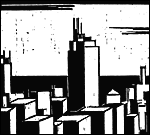William H. Whyte, The Exploding Metropolis (Doubleday, 1958) Reissued by University of California Press in paperback in 1993. The pretext for William H. Whyte's The Exploding Metropolis is simple: "This is a book by people who like cities." They are not architects or city planners, businessmen or political pundits. No, Whyte and his fellow colleagues from Fortune magazine who created this collection of essays are city dwellers. They love walking through streets and exploring communities, and enjoy considering the potential for urban enclaves to become heterogeneous cultural centers. In the context of post-war America in the 1950s, with its middle-class exodus to the suburbs, Whyte and several of his colleagues created this collection of essays to consider the "building and rebuilding of the American metropolis." They scrutinized the changing cultural landscape, one where the suburbs offered leisure and benign comforts, but lacked the heterogeneous values of the city. The city "exposes children to all kinds of people, colored and white, old and young, poor and rich," writes Whyte, bemoaning the one-class nature of the suburbs. "Here they are breeding a whole generation that will never know the city at all." Those that do know the city know it well, as if, in many cases, it was an extension of themselves. Jane Jacobs, in her essay "Downtown Is for the People," her precursor to her celebrated "The Death and Life of Great American Cities," writes, "You've got to get out and walk." Architects, she says, attempt to see a city from an omniscient perspective, one that looks at cities from above, seeing entire city blocks where a network of streets should be. They do not consider the grocer or the shoe shiner; instead they are overwhelmed by their grandiose ideas, often to the detriment of the community. Again and again, the essayists break down the sections of cities that we take for granted: the perfect placement of a park bench, the aesthetic pleasure of a fountain, the garish nature of a public housing project whose pragmatic design serves neither the inhabitant nor its neighbors. The ideas expressed in Exploding Metropolis still ring true today, as gentrification slowly spreads, replacing the small grocery with a Starbucks and as we hire planning boards and debate architects for the rebuilding of Ground Zero. But as we prepare our blueprints and pull out our bulldozers in preparation for the next urban development project, Jane Jacobs reminds us to ask: "In short, will the city be any fun?" MORE: The Project for Public Spaces New York Times Obituary of Whyte Profile of Whyte in Planning Magazine |
 |
|||||||||||||||||||||||||||